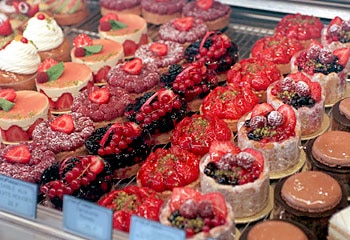Paris by pastries
PASTRIES are an essential part of the good life in Paris so what better way to tour the city than by eating at its patisseries. Garry Marchant tries some of the best.

PASTRIES are an essential part of the good life in Paris.
Small shops, centuries-old maisons de patisserie and grand salons de the produce artistic creations with elegant names such as clafoutis pruneaux-armagnac, tarte aux noix au sirop d'erable or feuille d'automne. The range of these gooey, delicious pastries includes gateaus, strudels, macaroons, sacher tortes and meringues. Artistic bakers fashion culinary masterpieces from eggs and sugar, chocolate and cream, fruits, nuts, honey and syrup. Parisian patisseries include small, family-run shops, elegant galleries that seem more like museums and fine dining rooms. Here is a baker's dozen of Paris's finest pastry outlets.
ANGELINA
226 rue de Rivoli (Metro: Tuileries).
THIS elegant patisserie and tea salon a few blocks from the Louvre was founded in 1903 and is set in an elaborate, fin-de-siecle dining room. With its 19th-century gold-leaf ceiling mouldings, rococo murals and ornate gilt plaster work, the decor is as frothy as the pastries. The fine confections include tarte aux fruits rouges and the Mont Blanc, resembling the Swiss mountain, with pureed chestnut on a meringue base, topped by Chantilly (whipped) cream.
AU PANETIER
10 place des Petits-Peres (Metro: Bourse).
ONE of the oldest Paris patisseries, this basic shop with old-fashioned gas-style lamps has tiled walls and frosted glass depicting a rural scene with a church and windmill. Besides the standard croissants, pain au chocolats and excellent breads, the bakery produces outstanding fruit tarts, especially cherry and rhubarb.
BROCCO
178 rue du Temple (Metro: Temple or Republique).
AN odd decor has evolved in this delightful shop founded in 1889; dolls in lace wedding dresses placed around the room complement the elaborate tiled walls and oil painting of a nude on the ceiling. Specialties include incredibly sweet chocolate treats such as pralines or the turn-of-the-century classic, the Opera, with almonds, coffee syrup, cream and chocolate.
CARTON
6 rue de Buci (Metro: Odeon).
THE decor in this shop in the fashionable 6tharrondissement is gallic art deco, with glass and chrome, black tiles and curvilinear lines. The pastries, however, are traditional. Cakes displayed in the window are edible sculptures of flying birds, Carmen Miranda-type turbans topped with real fruit, or abstract shapes. The shop also produces its own brand of chocolates.
DEBAUVE ET GALLAIS
30 rue des Saints-Peres (Metro: Saint-Germain-des-Pres).
IN 1800, Messieurs Debauve et Gallais, pharmacists to Louis XVI, founded this store as suppliers to the king. The gracious storefront is dark green, with gold letters and gilt wreaths over the door. Passing through the door is like entering a temple of chocolate, with its curved wooden desk like an altar, a row of Grecian columns behind and the rich bouquet of chocolate. Shopping here is serious business, with attendants in quasi-ushers' uniforms and white gloves helping clients select from more than 40 varieties of chocolates, served in bulk or in elegant boxes wrapped with blue ribbon.
FAUCHON
24-26 place de la Madeleine (Metro: Madeleine).
ONE of the most elegant and famous stores in Paris, this imposing conglomeration of shops taking up much of one side of the square has been purveying fine food since 1886. The patisserie, across the street from the tea shop, sells a great array of traditional and original pastries packaged in little pink boxes. Tarts include fruits de la passion, topped with strawberries, raspberries and blueberries, Figaro, with pistachio and figs, and tarte au the, resembling an ice hockey puck. The lemon is especially delicious, tart as its name, but not too sweet. The service is also tart, and not as agreeable as the pastries.
FLORENCE FINKELSZTAJN
24 rue des Ecouffes (Metro: St Paul).
THE sign on the window reads: Gastronomie Europe Centrale et Russie. Polish immigrants founded the original store on this colourful Jewish street in 1851 and now two family-owned shops – delis rather than bakeries – sell specialties such as cheesecake, poppy seed, fig or date cakes, huge cinnamon-sprinkled apple strudels and golden loaves of bread, baked on the premises.
GERARD MULOT
76 rue de Seine (Metro: Mabillon).
WINDOW displays of elaborate cakes include jour et nuit, made with white and dark chocolate; feuille d'automne, with wavy leaves of chocolate; and Valle de Loire, like a still life of fruits and berries. Long glass cases display rows of tasty cakes, and tarts such as tarte aux poire et figues are baked in a large sheet and sold by weight. A house specialty, Amaryllis, is a sweet almond macaroon with cream and seasonal fruits.
LADUREE
16 rue Royale (Metro: Madeleine or Concorde).
IT is hard to know what to appreciate more in this salon de the established in 1862, the excellent pastries or the beautiful, ornate dining room that could be used as a setting for a regal 19th-century banquet scene in a film. Gilded ceiling mouldings and ceiling oil paintings of maidens and cherubs form a suitable backdrop for lunchtime crowds nibbling appetising pastries. Other customers line up for take-out cakes, tartes and especially the famous macaroons flavoured with bitter chocolate, pistachio, vanilla, lemon, strawberry or pear. There are three other Laduree shops in Paris.
MICHEL CHAUDUN
149 rue de l'Universite (Metro: Invalides).
THIS confectionery, which specialises in chocolates, rates a four bon-bon classification from aficionados of the cacao bean. The eponymous proprietor, an artiste du chocolat, decorates his windows with chocolate figurines of rabbits, chickens and their chicks. Chaudun's original creations include chocolates exquisitely flavoured with orange or rum, and le pave de 1968, bite-sized blocks of dark chocolate named for the paving stones the students tore up from rue de l'Universite during the revolt that year.
PIERRE HERME
72 rue Bonaparte (Metro: Saint Sulpice).
YOU can spot this shop from afar by the queue at the door. Pierre Herme, who once baked for Fauchon and Laduree, now has his own modern patisserie that is ultra trendy, not traditional. Minimalist decor is limited to a few huge, overexposed photos of white cakes hanging behind the counter, while the staff are in fashionable black. Even the cakes seem minimalist, like thick discs in stark colours. A house specialty are the macaroons in red, green, white, brown and beige.
PATISSERIE STOHRER
51 rue Montorgueil (Metro: Chatelet-Les Halles).
FOR 270 years, Stohrer has offered its delicacies on this lively, historic, cobble-stoned street. A marker outside the shop explains that in 1725, when Louis XV married Maria Leszczynska, daughter of Poland's Stanislaw I, she brought her father's pastry chef with her to Versailles. In 1730, the chef moved to Paris to open what is now the city's oldest patisserie. Stohrer's specialties include rich puits d'amour (wells of love) and creamy, delicate millefeuilles.
VERLET
256 rue Saint-Honore (Metro: Tuileries or Concorde).
FOUNDED in 1880, this small cafe is a cosy little room with mirrors and old wood, huge burlap sacks of coffee beans and large old tea tins painted with Japanese scenes. This coffee merchant, with the heavenly fragrance of beans freshly ground on the premises permeating the air, sells exotic teas and coffees to take away. A simple fruit crumble with rhubarb, raspberry and apple is as delicious as the fancier offerings of Paris's grander establishments.



